Prehistoric Art – Discover Important Prehistoric Artifacts and Works
Each day, we are bombarded with art imagery produced daily by millions of artists across the globe. It is useful, now and then, to remember the roots of our creativity and perhaps draw inspiration from it. Also known as parietal art, prehistoric art was the beginning of creativity that gave birth to artistic expression, early human abstraction, and many other forms of mark-making that continue to feature in modern and contemporary art. This article will delve into all you need to know about prehistoric art. Read on for a full breakdown of prehistoric art history, including the most famous documented forms of prehistoric art.
What Is Prehistoric Art?
When you think of prehistoric times, you may find yourself drawn to images of cavemen and a time before history could even be documented – prehistory if you can name it. Art is considered one of the most complex phases of human development and the ability to express artistic inclination is one factor that is very important to the definition of the modern human species.
Prehistoric art is defined as art that is created in preliterate cultures, prior to the geological time period when humans began documenting history for the sake of record-keeping.
The term prehistoric varies for different cultures in different parts of the world since many societies developed at their own pace. Many major historical events, significant to each specific culture, were documented through early art and featured in parietal works via prehistoric drawings, paintings, engravings, sculptures, and decorative mark-making activities.
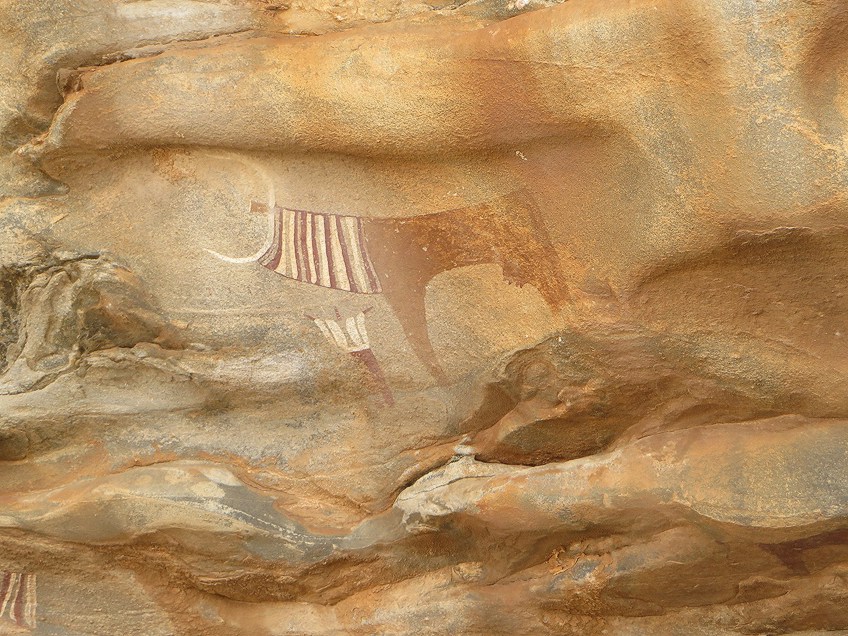
Parietal art encompasses artifacts and any object or visual imagery found in or around cave systems. To identify an object or image as art or possessing artistic intention is usually determined by locating evidence of craftsmanship or decoration. Evidence of workmanship can be found as early as 40,000 years ago in the Upper Paleolithic era.
In 2018, a discovery was made that found that the earliest drawing made by our species, Homo sapiens, dated to approximately 73,000 years old, which really put into perspective the longevity of art and possibly marked art as something that was inherent to the human species.
You may disagree, arguing that some individuals are not artistically inclined or are more “left-brained”; however, you may reconsider this after noting that creativity may be a crucial part of human survival. Without the ability of innovation and creative thinking, many societies would not be where they are today. Creativity and art are also essential for child development and even entrepreneurs and CEOs have reported that creativity is one of the most important skills that contribute to “success”.

Prehistoric art also includes engravings, many of which are found not only on cave walls and rock slabs but also on shells. The earliest known engravings were made by our predecessor, Homo erectus, and date right back to 500,000 years ago. Science, anthropology, archaeology, and art are heavily interconnected when it comes to prehistoric art and the validity of certain discoveries as “art” or simply a “discovery”.
Prehistory: Time Periods
Prehistory concerns itself with the periods that occurred before man could make their record of daily life for historicization. Art made during prehistory is now considered documentation of earlier times simply due to the valuable information contained in the visual depictions of prehistoric art.
So what is prehistory made up of? Prehistory is made up of different time periods, namely the Paleolithic, Mesolithic, Neolithic, Bronze Age, and Iron Age.
Before we delve into prehistoric artworks of the different periods, it is useful to understand the following abbreviations for the time associated with prehistory. The abbreviation “kya” is equivalent to “thousand years ago” and the abbreviation “BP” refers to the period before the present. “BCE” refers to “before the common era”, otherwise understood as the years before the birth of Jesus Christ.
Paleolithic Art (c. 40 – 8 kya)
The Upper Paleolithic era is considered the most profound period of transformation on a global basis. This period refers specifically to the period between 40 and 10 kya BP. During this period, the Earth saw rapid development in technology through stone tools, including art objects, the beginning of bodily decoration, jewelry production, sculptures, early language, and writing systems.
The main characteristics of art from the Upper Paleolithic era include cave paintings, drawings, jewelry, carvings, sculptures in clay, antlers, bones, ivory, Venus figurines, and even flutes for music. Below, you will find a few famous prehistoric artworks from the Upper Paleolithic era.
Hayonim Cave Horse Carving
| Date | 40 – 18.5 kya |
| Medium | Carving on stone with traces of ochre |
| Location | Israel Museum, Jerusalem |
The Near East also features important prehistoric art objects such as the horse carvings on stone and cave walls at the Hayonim cave in Israel. This art object is significant due to it being classified as the first art object of the Levantine Upper Paleolithic era.
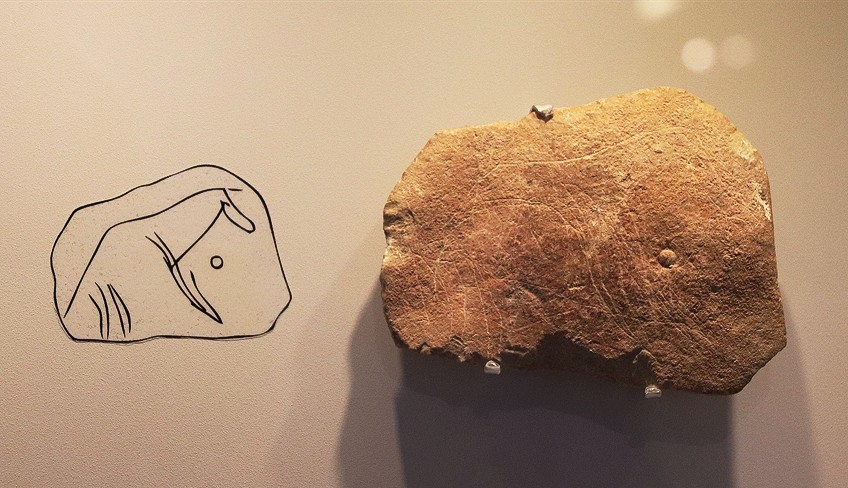
While we may assume that only modern humans have produced art, it is important to keep in mind that around this era, modern humans also coexisted with many other different species such as the Neanderthals and even hybrids.
Alongside the depiction of horses were other symbolic shapes and images found at the Hayonim cave, which is a crucial site for understanding one of the key moments in evolutionary history.
Hand Stencils at Pettakere Cave
| Date | 39.9 kya |
| Medium | Mineral pigments on cave wall |
| Location | Maros, Sulawesi |
The Sulawesi Island in Indonesia is home to some of the oldest cave paintings in Asia and the oldest figurative prehistoric drawings in the world. The hand stencil paintings are one of the oldest dated art forms present on the island with a minimum date of around 39 kya. Other sites in Asia such as South Korea were found to contain carvings on deer bones and featured images of deer dating back to 40 kya.
Another island in Indonesia, Borneo, also contains one of the oldest figurative paintings in prehistory, dated at 40 to 52 kya and depicts an unidentified animal at the cave of Lubang.
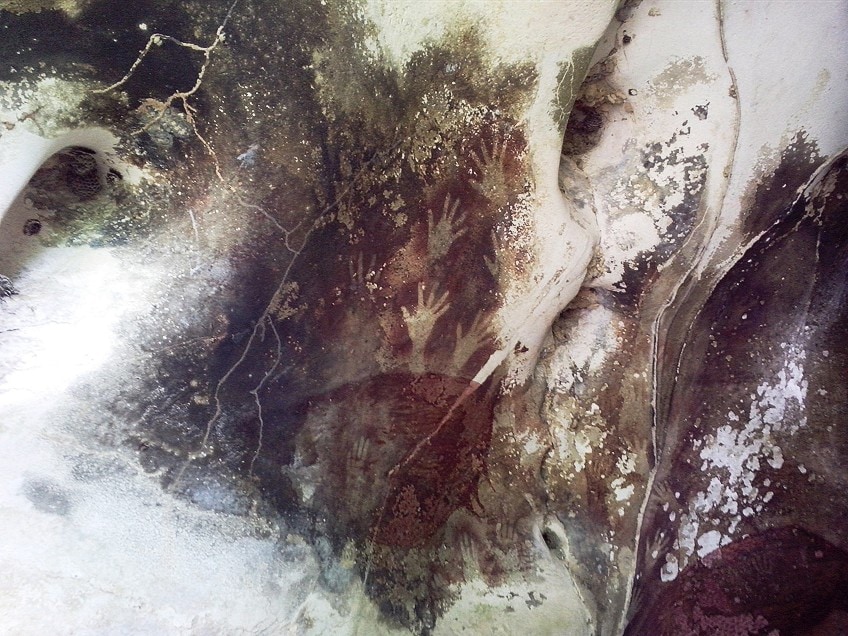
The Venus Figurines
| Date | c. 25 – 30 kya |
| Medium | Oolitic limestone |
| Dimensions (cm) | 11.1 (h) |
| Location | Naturhistorisches Museum, Vienna, Austria |
The human figure did make its appearance through sculpture, captured beautifully in the famous Venus figurines. These prehistoric artifacts are also considered art due to their exaggeration of the features of the Venus sculptures. As seen below in the Venus of Willendorf (c. 25 – 30 kya), there appears to be a lack of detail placed on the facial features and more emphasis on the figure of the woman with large breasts and a wide torso. It is said that these figures were probably made in celebration of reproduction or perhaps as totems for fertility.
Other key prehistoric artifacts include the Venus of Hohle Fels (40 – 30 kya) and the Löwenmensch figurine (35 – 40 kya) of Hohlenstein-Stadel.

Bison Cave Painting at the Cave of Altamira
| Date | 17 – 12 kya |
| Medium | Mineral pigments on the cave wall |
| Location | National Museum and Research Center of Altamira, Cantabria, Spain |
This polychrome painting on a cave wall at Altamira is one example of a prehistoric painting from the Upper Paleolithic period in Europe. The use of mineral pigments is considered one of the earliest mediums available to man that sparked the development of artistic expression. During this period, many cave paintings rarely featured the depiction of human figures but often showcased the natural environment.
Specifically, the animals were featured since food was one of the most important elements of survival for early humans, so why not capture it, right?
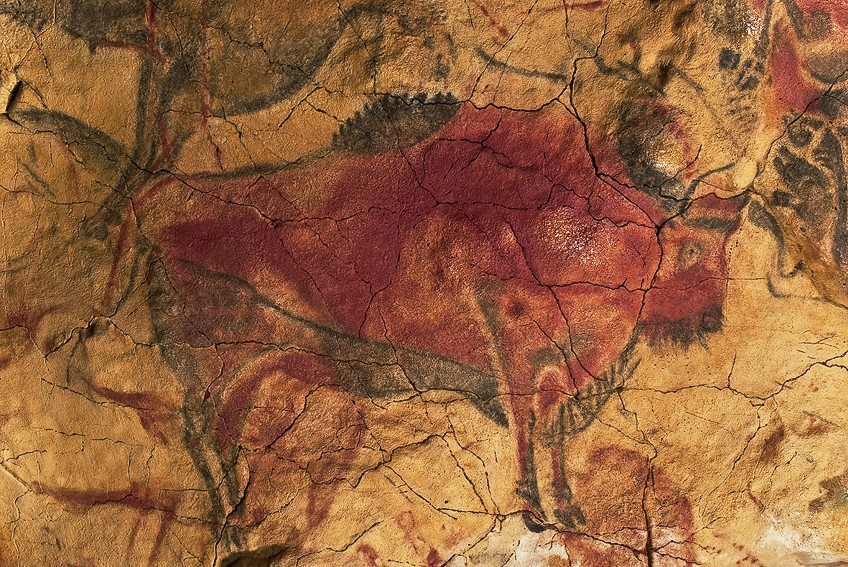
Magdalenian Charcoal Drawings of Altamira
| Date | Between 20 kya, 35.5 kya, and 15.2 kya BP |
| Medium | Charcoal and ochre pigments |
| Location | Santillana del Mar, Cantabria, Spain |
The cave paintings and prehistoric drawings found at the cave of Altamira in Spain were traced back to the Upper Paleolithic within the Aurignacian period, which is the first section of the Upper Paleolithic era. The artwork produced in this cave dates between 20 kya, 35.5 kya, and 15.2 kya BP.
Prehistoric drawings and paintings were executed in charcoal, as well as ochre pigments.

For example, the artwork Black Bison Head shows a prehistoric drawing from the Lower Magdalenian period of a bison’s head drawn in black charcoal dating back to 15.4 kya. Themes around this period revolved around animals such as the bison, horses, red deer stags, aurochs, signs, and even partials of a few human faces.
The art within the cave of Altamira also features polychrome artworks, engravings, and one of its best masterpieces, the ceiling with red horses.
Mesolithic Art (c. 10 – 2.7 kya BC)
Mesolithic art can be understood as art produced from the end of the Paleolithic Ice Age era, approximately 10,000 BCE, and is known as the Middle Stone Age. While Paleolithic art is often reflected upon in the context of the Upper Paleolithic era, the Mesolithic era is considered the transitory period of humans from hunter-gatherers to agricultural farmers.
Below, we will look at a few examples of prehistoric art, as captured by the creatives of the Mesolithic era.
The Dancers of Bhimbetka in India
| Date | c. 30 kya |
| Medium | Vegetable pigments |
| Location | Bhimbetka, India |
Discovered by Indian archaeologist, Dr. Vishnu Shridhar Wakankar in 1956, the Bhimbetka Rock Shelter in India is one of the most intriguing archaeological sites for cave paintings. The cave shelter contains scenes of people hunting, conducting social rituals, and even dancing, as seen in the Dancers of Bhimbetka.
The rock shelter is now classified as a UNESCO World Heritage Site and is one of the most important archaeological sites in India – a must-see if you are planning a trip to India!
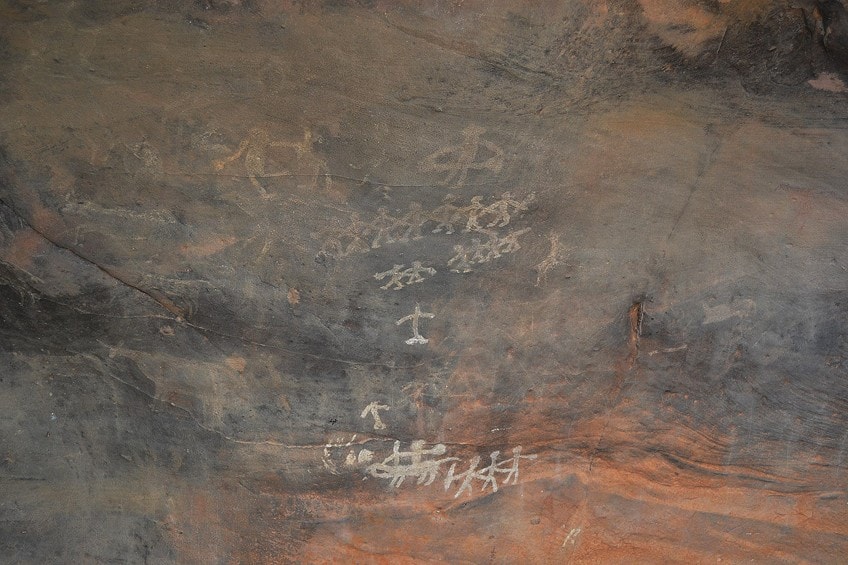
The Kimberley Rock Art of Western Australia
| Date | Post c. 25 kya |
| Medium | Mulberry, a red mineral pigment |
| Location | Kimberley, Australia |
While the majority of cave art from Western Australia remains undocumented, there are two major groups of cave art in the region; the Wanjina paintings and the Gwion paintings with the latter being the oldest. Many early paintings in the region are life-sized and naturalistic with depictions of many animals, plants, human forms, and fish.
The paintings were often made using mulberry pigment or red mineral pigments and outlined with long brush strokes.

Just after 25 kya BCE, many handprints and negative hand stencils were created on rock surfaces. The appearance of the hand in rock art later progressed to different styles and by around 6 to 2 kya, painted hand imagery was applied in broad brush strokes over older paintings as motifs.
Some motifs also feature complex geometric patterns and are often compared to the Neolithic era of Europe.
Göbekli Tepe Relief Sculptures
| Date | 9.1 – 8.8 kya BCE |
| Medium | Limestone |
| Location | Göbekli Tepe, Şanlıurfa, Turkey |
The Mesolithic period also marked the emergence of plastic art, derived from the term “plasticize”, which involved molding or modeling substances for a three-dimensional effect or sculpture. While the Paleolithic era featured Venus figurines, the artists of the Mesolithic period took to relief sculpture and a few free-standing pieces.
After the Ice Age, Europe started to see the regrowth of new forests and wood carving eventually became popular.

A great example of relief sculpture from the Mesolithic period includes a relief sculpture in the shape of a bull, fox, and crane in layer III of the Göbekli Tepe in Turkey. This cave exists as one of the world’s most important religious archaeological sites.
European Prehistory Art of the Mediterranean Basin
| Date | c. 8 kya BCE |
| Medium | Various mineral pigments |
| Location | Andalusia, Aragón, Castilla-La Mancha, Catalonia, Murcia, Valencia, Spain |
The Mediterranean Basin located on the Iberian Peninsula is an important European site containing around 758 sites covering over 1000 kilometers of the coast. The rock art of the Mediterranean Basin depicts simple figures in paintings with predominantly black and red pigments.
There is also the rare occurrence of yellow and white pigments.

The scenes at these sites are spread across six individual communities and are considered to be one of the first narrations of European prehistory since they depict scenery containing evidence of rituals, feminine divinity, witch doctors, archers, therianthropic creatures, and funeral rite activities, all of which provide valuable information on the different cultures.
Neolithic Art (c. 10 – 4.5 kya BC)
The move to the Neolithic period also signified the move away from a hunter-gatherer-centric and nomadic lifestyle toward animal husbandry and farming practices. Some primary art forms of the Neolithic period include pottery, terracotta sculpture, mobiliary art, hand stencils, and engravings.
As in most cases concerning the subject matter of prehistory art, everyday life was at the top of the list for most artists.
The emergence of agriculture took precedence during the Neolithic era and allowed for a growth spurt in the population. This gave rise to the need for organization and soon Neolithic society developed stronger beliefs toward the supernatural, which as you might expect, also featured in Neolithic artwork. Below, you will find a few artworks from the Neolithic period that illustrate the subject matter of the time.
The Thinker of Cernavoda
| Date | 5 kya |
| Medium | Terracotta sculpture |
| Dimensions (cm) | 11.5 x 7.5 |
| Location | National Museum of Romania |
Discovered in 1956, this famous prehistoric sculpture, also referred to as The Thinker, was unearthed in a Neolithic settlement from the lower Danube area in Romania. It is believed that the sculpture was forged during the existence of the Hamangia culture around 5,000 years ago and is the oldest sculpture to depict the act of introspection as opposed to the more common representations of animals or fertility objects.
The deep brownish-red sculpture portrays a human figure, perceived as male, seated on a stool with his hands holding his head and his elbows resting on his knees.

The physique of the figure is also unusual since the head is small and angular and the neck is thick and long. The eyes on the figure also appear large and disproportionate to the face, executed as concave, which was uncharacteristic of common Romanian sculptures. The Thinker was crafted out of unglazed terracotta with a clay-based ceramic and lacks the decorative elements of sculpture normally seen in the plastic art and other ceramic objects of the Hamangia and Cucuteni cultures.
The sculpture can thus be thought of as the first sculpture made for the sake of art from the Neolithic period and is currently housed at the National Museum of Romanian History in Bucharest.
Chalcolithic Bowl of Persia
| Date | c. 4.5 – 4.1 kya |
| Medium | Ceramic, paint |
| Dimensions (cm) | 7.62 |
| Location | Iran, Tall-i Bakun A |
Crafted out of fine buff clay, this Chalcolithic bowl dates to around 4500 to 4100 BC and is an excellent example of an art object that showcases the development of the Neolithic era art form. Unearthed around 1932 in Tall-i Bakun A, Iran, the seemingly simple bowl was decorated with brown paint with two wide horizontal lines and overlapping X’s between them.
The markings on the bowl also indicate that the surface was completed with a slow wheel.
It is believed that this bowl was probably used for drinking, given its small size. The area where this bowl was excavated was also a major trading hotspot for pastoral nomads and farmers. The region progressed to become an important administrative site and became a site for pottery production to thrive.
Egyptian Female Figure
| Date | 3.7 kya |
| Medium | Bone, lapis lazuli |
| Dimensions (cm) | 11.4 x 2.1 |
| Location | The British Museum, London |
This bone-sculpted figure originated from the Naqada I period in Egypt, dating back to 3,700 years ago, and was acquired by the British Museum around 1899. The figure shows a woman standing upright with pieces of lapis lazuli lying inside the cavities of her eyes. It is believed that the addition of lapis lazuli occurred later on after the sculpture was made, perhaps in modern days.
It is unclear who the woman is but lapis lazuli in ancient Egypt served the purpose of leading the soul into immortality and opening one’s heart to love.
Bronze Age Art (3.3 – 1.2 kya BC)
The Bronze Age in prehistoric art was also the period where metalwork emerged and introduced new mediums for artistic experimentation and style. During this period, approximately 3300 to 1200 BC, the production of objects and imagery for art were made clear. Some important art forms during this period included objects crafted out of bronze, which is an alloy metal made out of copper and tin, in addition to other objects and tools for functional uses, ornaments, helmets, decorative elements, elegant ceramic designs, and bronze casting in sculpture.
Below are a few examples of prehistoric art from the Bronze Age.
Minoan Frescoes of Crete
| Date | c. 1700 – 1450 BC |
| Medium | Varied pigments |
| Dimensions (cm) | Unavailable |
| Location | Knossos, Crete |
Known as the seafaring culture, the Minoan civilization occupied the Bronze Age Crete from 2000 to 1500 BCE. Many artists from this civilization took an interest in naturalistic art, including depictions of marine animals, plants, sculptures, pottery, jewelry, and even frescoes.
The art produced by this culture provided valuable insights into the ritual and funerary activities of the ancient Mediterranean people.
Frescoes, as seen in Griffin Facing the Throne (1.7-1.4 kya), were made as decoration for the Minoan palaces and included the use of various colorful pigments on wet lime plaster walls. The prehistoric artists did not make use of a binding agent for preservation purposes since the paint was absorbed by the plaster and was a preventative measure to avoid fading. The common color palette for Minoan frescoes included blue, red, white, black, yellow, and green with many color conventions that were also believed to have been adopted from the architectural artwork found in Egypt.

The Minoans used the color red for male subjects and white for female subjects. Metals in prehistoric art were designated their appropriate colors; bronze was red, blue represented silver, and yellow was used for gold. The imagery of the Minoan frescoes contained geometric designs, small, and life-sized subjects. Other scenes portrayed in Minoan frescoes included bull sports, scenes from events and rituals, landscapes, and nature scenes.
This culture is also considered one of the first civilizations to depict the natural landscape without the presence of humans.
Sanxingdui Bronzes in China
| Date | c. 1600 – 1046 BC |
| Medium | Bronze, gold foil mask |
| Dimensions (cm) | Unavailable |
| Location | Sanxingdui Museum, Deyang, China |
The Sanxingdui culture was known to create these magnificent bronze faces, which portray exaggerated features with dignified expressions. One such example can be seen in the Mask with gold foil by an unknown artist from the Shang Dynasty. It is said that this was potentially a way that the Shu people memorialized their ancestors.
The mask is covered with gold foliage across the front section and is one of four sculptures covered in gold in addition to 57 other bronze sculptures.
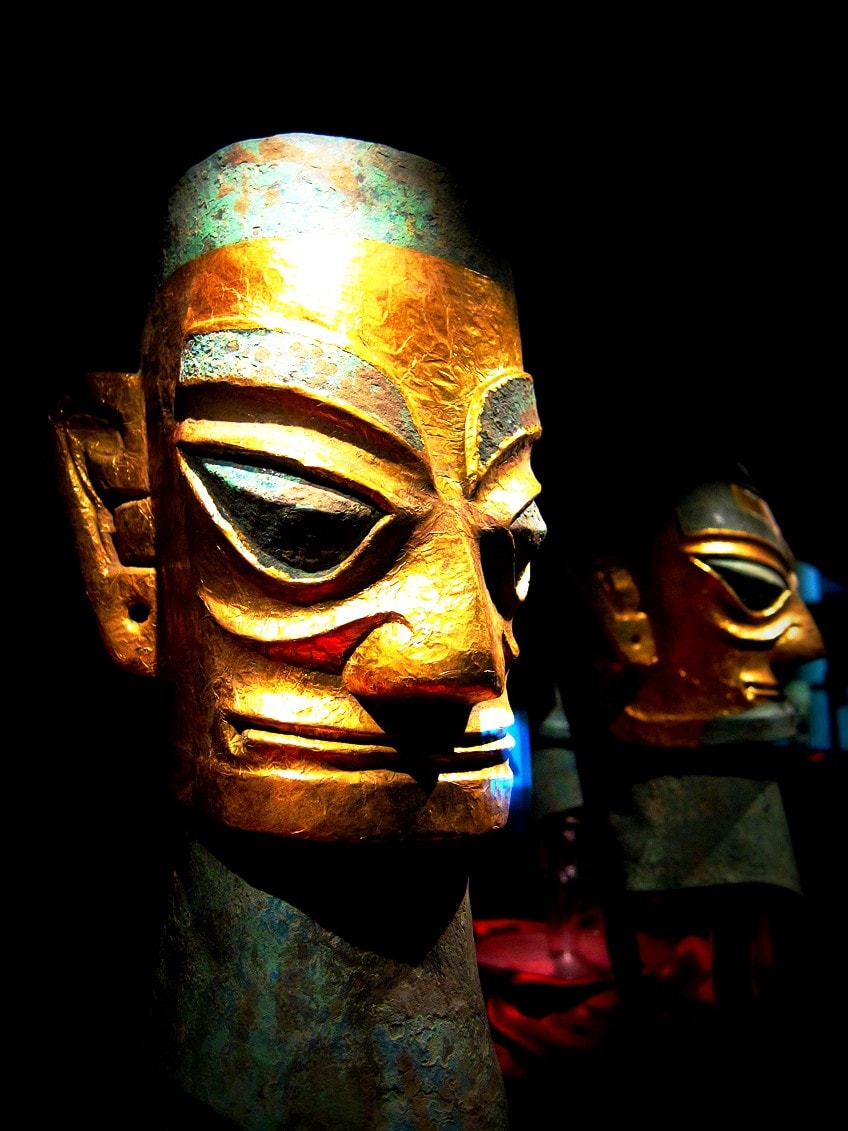
The gold-embellished faces are said to have belonged to wealthy owners. The gold, which is 85% pure gold, is believed to have been glued on using a mixture of lacquer and lime. All 57 bronze sculptures vary in head shape and size and researchers have suggested that this could indicate different races or personalities.
Hittite Silver Drinking Vessel
| Date | c. 1300 |
| Medium | Silver |
| Dimensions (cm) | 18 x 12.8 x 21.5 |
| Location | Metropolitan Museum of Art, New York |
The Hittites were the first group of people situated in Anatolia, Turkey, to begin mining and relying on iron. The majority of Hittite art was created under the Imperial regime of King Suppiluliuma I, where control over the region grew across Anatolia, Syria, Upper Mesopotamia, and Lebanon.
This silver bull is a drinking vessel and depicts the bull kneeling with a short neck, oval-shaped eyes, petal-ridged jowls and cheeks, and attention to the folds of skin.
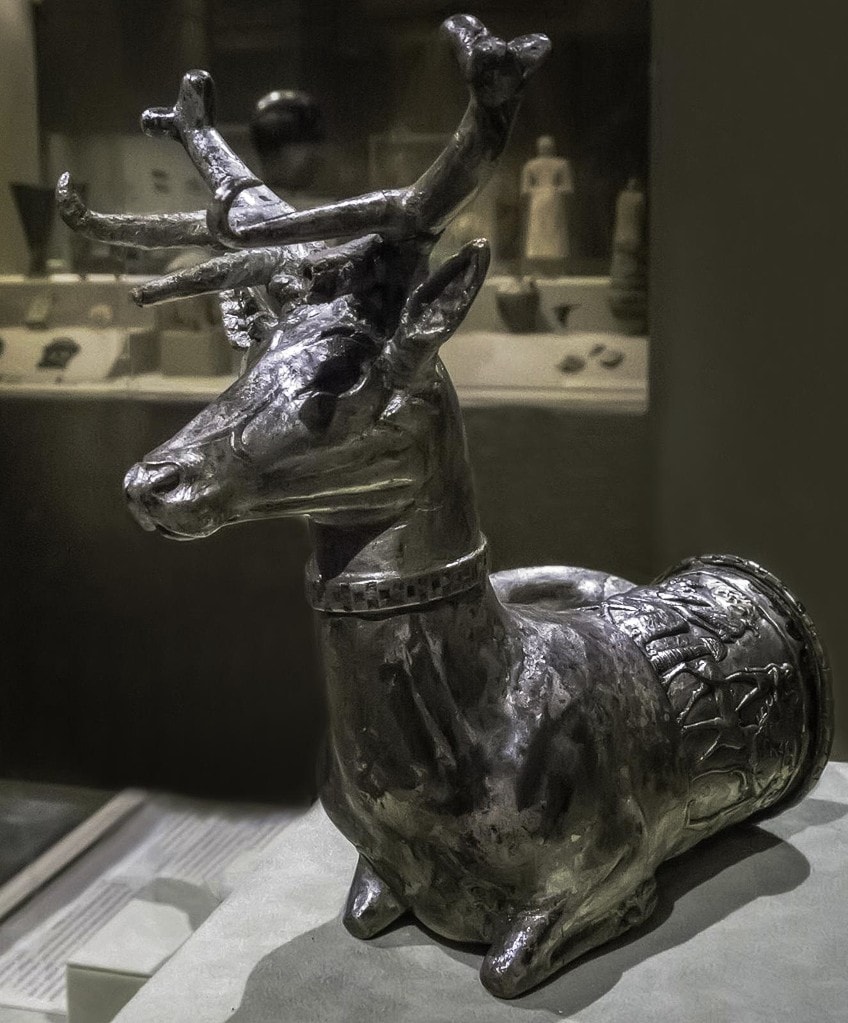
Such modeling in this sculpture is also found in other bull sculptures dating around the same period (c. 1300) and is said to signify the property of the storm God, Teshub, associated with the image of a bull. In Hittite culture, it was common to dedicate drinking vessels to the Gods.
Iron Age Art (c. 1200 – 200 BCE)
The Iron Age, which lasted from 1200 to 200 BCE, was witness to rapid development in the field of iron tools and technologies across the Eastern Mediterranean region. While the end of the Iron Age is variable and has been a topic of debate, it also marked the point at which Greek art began to thrive alongside Etruscan art.
The Iron age also witnessed the development of Greek Hellenic culture and Celtic art in central Europe.
The Mediterranean civilization is divided into seven other periods, namely: the dark ages, geometric, oriental-style, as well as the archaic, classical, and Hellenistic periods. Below, we will review a few examples of prehistoric art from the Iron Age.
The Kouros Marble Statue
| Date | c. 590 – 580 BC |
| Medium | Marble, naxian |
| Dimensions (cm) | 194.6 x 51.6 x 63.2 |
| Location | Metropolitan Museum of Art, New York |
Kouros is an example of an Archaic period Greek statue resembling a naked man in a standing position. This marble statue dates to around 590 and 580 BC and is considered one of the earliest creations of the human figure produced in Attica.
The sculpture shows the man standing in a rigid demeanor with his left leg facing forward and arms to his side.
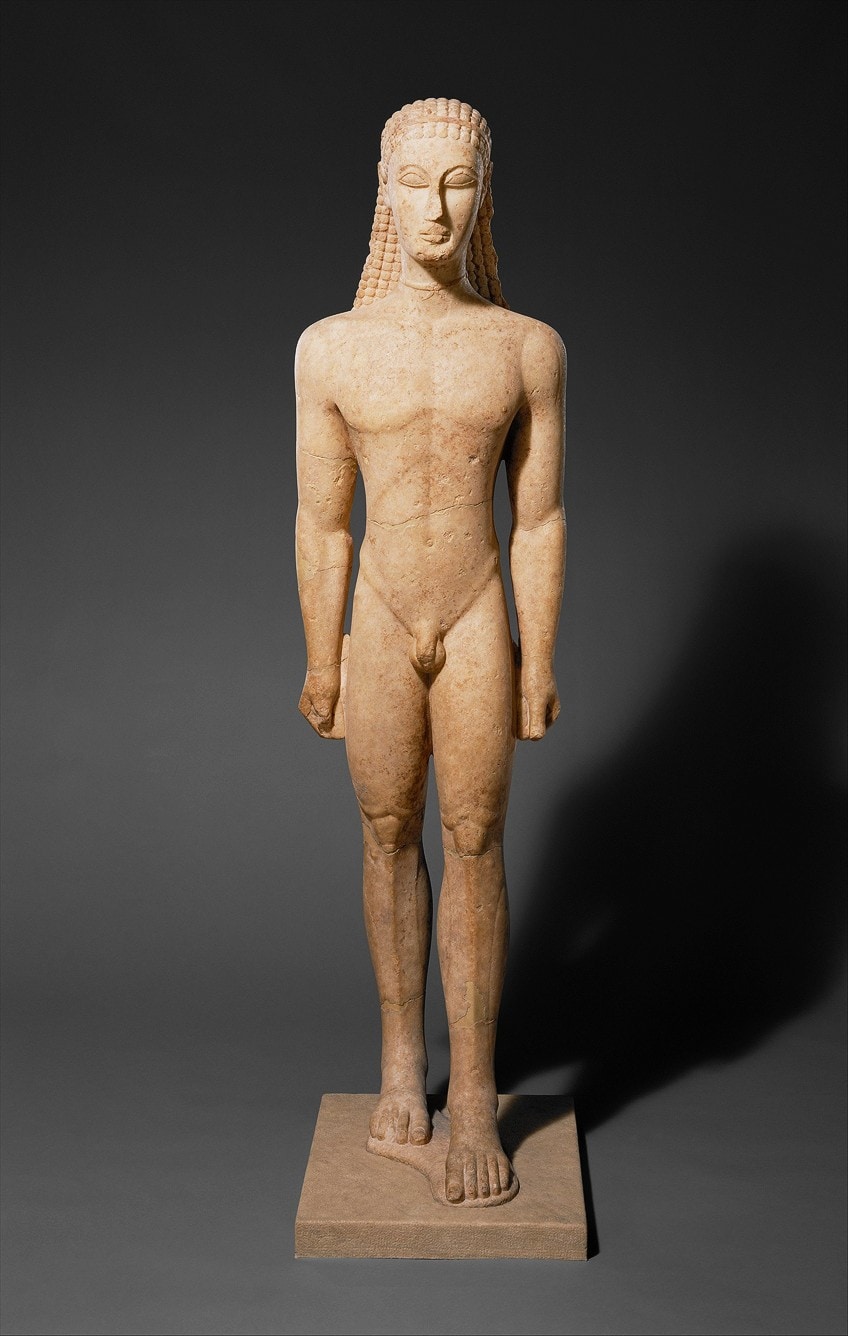
This pose, which was also borrowed from Egyptian art, was then adopted by many Greek sculptors, and the pose was featured in artworks throughout the sixth century. This statue was found at the grave site of one of the young aristocrats of Athens.
The Terracotta Army
| Date | c. 246 – 208 BCE |
| Medium | Yellow clay, grit |
| Dimensions (cm) | 184-197 (varied height) |
| Location | Emperor Qinshihuang’s Mausoleum Site Museum, Xi’an, China |
Since 18 kya BCE, China had begun creating early versions of pots and soon became the cornerstone of ancient pottery in Asia. The Terracotta army is one of the most famous archaeological discoveries from the Qin Dynasty and contains a massive collection of 8000 clay-sculpted warriors with horses located adjacent to the resting place of Qin Shi Huangdi, who was the first Qin Emperor of the Shaanxi province.
What makes this army so spectacular is that each piece is uniquely crafted and all the warrior sculptures also carry different facial expressions.

This indicated the level of thought put into the variety of sculptural work as opposed to the quantity. It is believed that this commissioned project took approximately 38 years to complete while employing over 700,000 workers. Indeed, this may be one of the largest artistic endeavors in the world to date.
The Broighter Hoard
| Date | c. 100 – 50 BCE |
| Medium | Gold |
| Dimensions (cm) | 19 |
| Location | National Museum of Ireland |
Celtic metalwork is also a part of the Bronze Age of Ireland, dating to around 3,500 and 1,100 years ago. The Irish artisans created many smaller works in the torc style using metals such as bronze, gold, and copper. The Broighter collar seen above was discovered in 1896 by Thomas Nicholl and is one of the most treasured finds of the Irish goldsmithing era and was discovered among a “hoard of gold objects” along the shores of Lough Foyle.
This object is in fact a neck ornament with buffer terminals and motifs featuring a bird and a horse.

During this period, collars were affiliated with Gods and Kings, specifically for the area of Lough Foyle, association was drawn with Manannán mac Lir, who was a sea God who may have been held in high regard by one of the local Celtic Kings. The name of the collar, Broighter, is said to be associated with the Irish term Brú Íochtair, which featured in early mythology as brú and íochtair. Brú refers to the home of a God while íochtair translates as lower. The collar is therefore also associated with the sea God’s residence.
While it may be difficult to pinpoint the correct identity of the prehistoric artist in most cases, some prehistoric artists we can put a name to are the notable muralists of the Classical period in Greece.
These include artists such as Micon, Zeuxis, Polygnotus, Parrhasius, and Apelles. Most of these prehistoric artists covered subject matter pertaining to the successes of politics and military affairs, which marked the turn of art away from decorative intentions.
Prehistoric art history has much to offer and gives us a glimpse into the development of art through the medium, technique, and visual illustration of the natural environment and subjects that were important to mankind. It is clear to see that art still carries significance as a practice through which we can express our feelings towards the things that matter the most to us and to the broader realm of human interaction with the environment.
Frequently Asked Questions
What Is Prehistoric Art?
Prehistoric art refers to the time period before humans began to record history as practiced today. The term prehistoric encompasses the time periods associated with the Paleolithic, Mesolithic, Neolithic, Stone Age, Bronze Age, and Iron Age eras. Prehistoric art, therefore, refers to art created within these time periods.
What Is the Most Famous Site for Prehistoric Art?
One of the most popular destinations to see prehistoric art includes the UNESCO World Heritage site in France, Chauvet-Pont-d’Arc Cave, which contains prehistoric artwork dating to around 36 kya.
What Are the Characteristics of Prehistoric Art?
The characteristics of prehistoric art include any artwork that dates back to any of the time periods that are classified under the term prehistoric. Some common characteristics of prehistoric art involve the use of mediums such as ochre, mineral pigments, vegetable pigments, and charcoal. Other mediums and art forms associated with prehistoric art include pottery, engravings, carvings, drawings, and sculptures. Prehistoric art is often discovered in environments that allow it to survive. This includes art found in cavernous systems, desert environments, ancient ruins, temples, and other areas that allow for the preservation of prehistoric art.
Jordan Anthony is a Cape Town-based film photographer, curator, and arts writer. She holds a Bachelor of Art in Fine Arts from the University of the Witwatersrand, Johannesburg, where she explored themes like healing, identity, dreams, and intuitive creation in her Contemporary art practice. Jordan has collaborated with various local art institutions, including the KZNSA Gallery in Durban, the Turbine Art Fair, and the Wits Art Museum. Her photography focuses on abstract color manipulations, portraiture, candid shots, and urban landscapes. She’s intrigued by philosophy, memory, and esotericism, drawing inspiration from Surrealism, Fluxus, and ancient civilizations, as well as childhood influences and found objects. Jordan is working for artfilemagazine since 2022 and writes blog posts about art history and photography.
Learn more about Jordan Anthony and about us.
Cite this Article
Jordan, Anthony, “Prehistoric Art – Discover Important Prehistoric Artifacts and Works.” artfilemagazine – Your Online Art Source. September 1, 2022. URL: https://artfilemagazine.com/prehistoric-art/
Anthony, J. (2022, 1 September). Prehistoric Art – Discover Important Prehistoric Artifacts and Works. artfilemagazine – Your Online Art Source. https://artfilemagazine.com/prehistoric-art/
Anthony, Jordan. “Prehistoric Art – Discover Important Prehistoric Artifacts and Works.” artfilemagazine – Your Online Art Source, September 1, 2022. https://artfilemagazine.com/prehistoric-art/.



